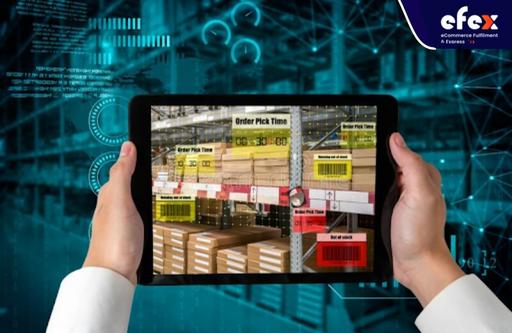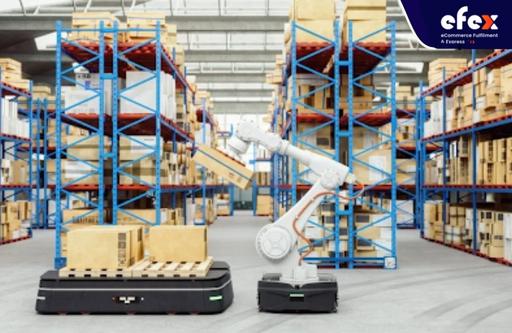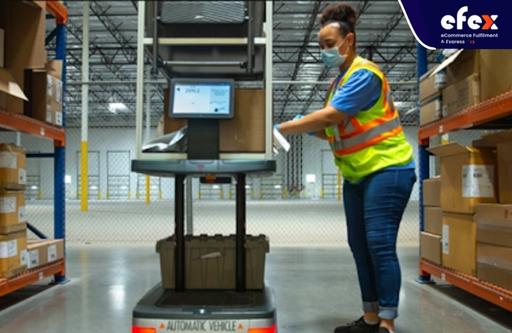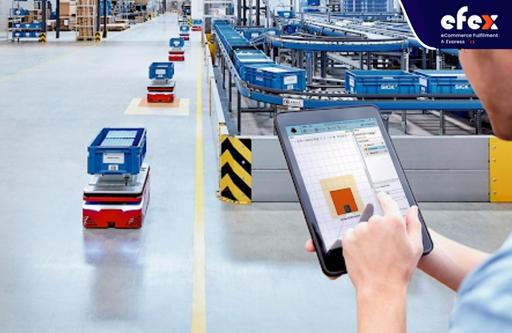
More Helpful Content
The misconception that warehouses only involve basic goods transfer is challenged by the impact of labor shortages, pandemics, and economic shifts. AI in warehouse management systems has revolutionized modern warehousing, enabling efficient handling of high customer demands, numerous SKUs, and rapid responses. Discover the transformative influence of AI in warehouse operations and explore its 5 applications for enhanced management.
AI is without a doubt a revolutionary technology. However, believing that only blue-chip corporations and significant international IT businesses may gain from AI would be incorrect. In the end, artificial intelligence will change every industry and corporation. If AI is not currently used in your warehouse facilities, it may be time to start. Here are some benefits that artificial intelligence can enhance your business operations in both the short and long-run:

By predicting patterns and enabling businesses to manage their stock and activities throughout shifting circumstances, AI helps businesses increase the amount of preparedness they have for various situations.
For testing and proving sophisticated technology like robots and drones, distribution companies are offering a secure environment. Additionally, it explains why DCs are conducting extensive AI research (AI).

According to a Lucas Systems-commissioned research study, a number of businesses now employ AI in their fulfillment and distribution processes and facilities. The poll also found that operators saw the cost, complication, and lack of knowledge on how to employ AI as major barriers to making additional investments.
In fact, AI will make tackling warehouse optimization problems like slotting and staff planning simpler and less expensive for DCs of all sizes. Furthermore, significant investments in information science fields won't be necessary for effective AI deployment. Effective AI depends on solid data, and DCs are an ideal setting for gathering and combining both historical and current data.
Also, AI is a good fit for operational difficulties in the DC sector that historically called for expensive, highly-engineered professionals. These barriers are lessened by AI as well as machine learning-based technologies, which also perform better for DCs than the present methods of resources and inventory control that depend on Excel, inherited best practices, or straightforward rules-based judgment. With the help of AI, sophisticated optimization is now possible for smaller companies and is more adaptable and affordable for larger facilities. Here are the top five uses of AI in warehouses today.
Although it's difficult, effective product slotting affects labor productivity, throughput, and accuracy. Slotting is a various objective optimization issue such as so many targets that conflict as well as a multimodal optimization problem such as so many entry factors to take into account.
Millions of products and their locations (or slots) are also available, and both of these factors should be taken into account. Customized models, considerable design, measurement, and information gathering are needed for both installation and maintenance of conventional slotting methods.

A large portion of the technical labor, warehouse mapping by humans, and data entry required by conventional slotting systems are reduced by AI. Based on the information collected in the DC, AI-based technology can learn the spatial attributes and travel time estimates necessary for a slotting model. Additionally, if situations change, the learned model will adjust, offering continual optimization.
Getting orders promptly while avoiding overstaffing as well as understaffing requires efficient labor allocation. Across a whole shift, managers in many DCs allocate personnel based on the amount of work, the timeframes, and the existing and anticipated productivity. Nowadays, decisions are frequently dependent on the particular strength and aptitude of each manager, which calls for reliable data and precise projections.

Machine learning is used to forecast labor needs and task completion times, which will produce better results. Moreover, an AI system can perform simulations to find the optimum way to do the job, preventing delays and guaranteeing the most effective use of personnel.
Engineered Labor Standards (ELS)-based labor management systems have been in use for ages. ELS-based productivity management relies on labor-intensive data collecting, which AI may greatly reduce by utilizing learning algorithms to estimate the length of time needed to accomplish activities.
Artificial intelligence (AI) algorithms learn based on actual performance data gathered from inside activity, considering a wide range of factors including job types, users, workplace, beginning travel place, ending travel place, goods to be handled, volume to be handled, and so on. When operational adjustments are made, the ML models adapt, improving the accuracy of the expected outcomes.
Reducing travel is essential to increasing productivity for warehouse employees since they spend a large amount of their workday moving around a warehouse. Robots and automation both reduce travel. Besides, AI can also be applied in places where automation by itself is insufficient.
With smart order batching and pick ordering, AI as well as machine learning systems know how to manage priorities and cut down on travel. The systems adjust for typical congested locations and slow routes. Numerous DCs have demonstrated 20–30% productivity benefits in case pick to pallet activities, and 2x productivity increases in part picking applications employing AI-based journey reduction.

The same methods used to coordinate humans and ARMs - autonomous mobile robots in the order-picking operation can also be applied to optimize worker travel. In the majority of pick-to-robot operating systems currently in use, a worker nearby gives one or more options to the robot following the instructions shown on a tablet placed on the equipment.
The robot system maximizes and guides the robots to a place. An AI-based executing system can coordinate and maximize the time of both the robots and the pickers, as well as provide a way to manage employees who are not AMRs. In order to properly organize and sequence the labor among humans and robots, machine learning algorithms forecast where the pickers and robots will be at a specific time.
The effectiveness of technology can be evaluated by looking at improvements in KPIs. Several KPIs that demonstrate how useful AI has been for warehouse automation are including:
Measuring the rise in warehouse productivity is one of the greatest ways to determine whether AI has shown to be advantageous. Processes for pick-and-pack are streamlined with the use of AI. AI programs are available 24/7. In addition, AI robots can be used to read electronic tags as well as provide precise and accurate inventory tracking. They can find the quickest routes to position goods and even prevent colliding with one another. They may be able to shorten the distance and time needed to place items in the warehouse inventory.
Accuracy is still another important factor. Mistakes in warehouse operations can be decreased by using AI technologies. Robots powered by AI are capable of understanding their surroundings, which allows them to set products precisely and recover them as needed. IoT, computer vision, and AI technologies can all be used in warehouses to increase operational precision.
Safety is a key factor as well. Warehouse activities can be continuously monitored by AI technologies. They can analyze the activities to get the risk score. High-risk jobs can be done by robots, while safer duties can be done by people. As a result, AI helps to increase employee safety in the warehouse. Furthermore, AI solutions utilizing AR and VR equipment can be utilized for training reasons to ensure that staff members are knowledgeable about SOPs. Thus, injury risks are reduced and personnel can receive training without risk.
👉 Read More: Types Of Warehouse Management Systems: Definition And Benefits
👉 Read More: Cloud-Based Warehouse Management System: Definition And Benefit
Automation of AI in warehouse management systems is not just a dream. The moment has arrived. To reach automation, big corporations like Alibaba and Amazon have already implemented AI into their warehouse management systems. In order to streamline operations, other organizations should also consider how to implement AI technologies in their warehouse. Hope you have a good time with EFEX - eCommerce Fulfillment & Express.


